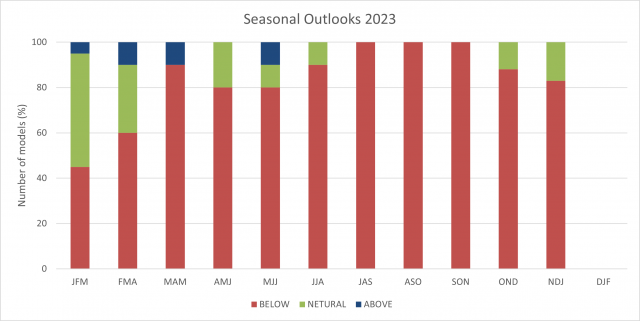Summary
Rainfall outlook for South West Land Division (SWLD) for August to October, and spring, September to November, is for below median rainfall, based on a survey of 20 national and international models. Higher chance of frost is expected for August.
Things to consider:
- The Bureau of Meteorology outlook for minimum temperature for August indicates 25-65% chance of exceeding median minimum temperatures, meaning higher chance of frosts occurring for the majority of the South West Land Division.
- The Bureau of Meteorology is continuing the El Niño Alert. The El Niño is forecast to develop in August as well as a positive Indian Ocean Dipole. This would reduce rainfall for the SWLD until November.
- Bureau’s ACCESS-S model indicates that there is an 80% chance of exceeding the median August to October maximum and minimum temperatures. This means there is high chances of warmer temperatures and reduced rainfall for August to October.
- Next cold front is forecast for 2 August with the Bureau of ACCESS model is indicating between 5-30mm of rain for the SWLD.
Rainfall outlook for the South West Land Division
Summary of 20 national and international models show that all models indicate below normal chances of exceeding median rainfall for the SWLD for August to October 2023 and further ahead to spring September to November. Survey of 7 models also has drier conditions continuing into November 2023 to January 2024. Remember, however, the further out the model forecasts, the least skill it has.
Frost events
Comparing number frost events for 1-27 July to the 2000-2022 average, you can see that there has been above average number of frosts in July. Highest number of frost events occurred in Moorine Rock with 17 nights below 2°C.
August average frost event map for 2000-2022, shows a similar pattern to July. The Bureau of Meteorology outlook for minimum temperature for August is indicating 25-65% chance of exceeding median minimum temperatures. This means a higher chance of frosts occurring for the majority of the South West Land Division.
Recent climate
The rainfall decile map for 1 April to 2 July 2023 indicates decile 1-3 rainfall for parts of the Central West, Central Wheatbelt, South West and Great Southern forecast districts. Parts of the Central Wheatbelt, Great Southern, South West and South Coastal and South East Coastal forecast districts have received decile 8-10 rainfall.
For information on climate drivers refer to the Bureau of Meteorology’s Climate Driver Update.
The latest plant available soil water map uses evapotranspiration of a generic wheat crop. This is estimated using the FAO crop factor method, where the timing of crop germination (break of season) is estimated using a two part rule, such that germination is assumed to occur if there is 25mm of rainfall over three days after 25 April and before 5 June, or if there is 5 mm of rainfall after 5 June. This map is for the mean of 10 soil types. For location specific and soil specific plant available soil water graphs see the soil water tool.

The potential yield map indicates the maximum yield possible given rainfall in the absence of any other constraints. Estimates of potential wheat yield is obtained using the French and Schultz potential yield model. Here two water use efficiency values are shown 12 and 15 kg/ha/mm and evaporation of 90mm (for later sowing and emergence, as the majority of the SWLD had a late break this year) with a decile 3 rainfall finish (as this is what the majority of seasonal outlooks are indicating). For location specific potential yield information, with selection of evaporation and WUE see the potential yield tool.





